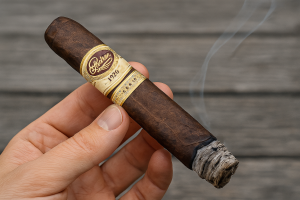How to Tell if Cigar Is Too Moist: Key Signs and Importance of Proper Humidity Levels

The condition of a cigar is just as important as its origin or blend.
Among the crucial aspects to consider is the cigar's moisture level.
A perfectly maintained cigar offers a smooth, rich experience, while a poorly kept one can lead to a subpar smoking session.
But how how to tell if cigar is too moist? We’re here to solve that dilemma.
- Appearance Can Easily Show You if a Cigar Is Too Moist
- Testing the Cigar's Feel and Texture
- Evaluating the Cigar's Combustion
- Utilizing a Hygrometer for Precise Measurements
- Remedies for a Moist Cigar
Appearance Can Easily Show You if a Cigar Is Too Moist
The first step in determining if your cigar is too moist is evaluating its appearance.
Visual inspection can provide valuable clues about the moisture level. Here's what you should look for:
- Observe the wrapper for any visible signs of moisture, such as oily spots or droplets. These are indicators that the cigar is retaining excess moisture.
- Check if the cigar feels excessively sticky or leaves residue on your fingers. If it does, this is another telltale sign of excessive moisture.
- Note any unusual swelling or bulging of the cigar. This can be an indication that the moisture content has caused the tobacco to expand beyond its natural state.
By carefully examining the appearance of your cigar, you'll be able to spot potential signs of excessive moisture.
Testing the Cigar's Feel and Texture
Another essential aspect of evaluating a cigar's moisture content is assessing its feel and texture. Follow these simple steps:
- Gently squeeze the cigar between your fingers. Pay attention to the resistance. A cigar that feels spongy or excessively firm might indicate high moisture content.
- Observe the texture of the wrapper. A dry touch suggests a well-preserved cigar, while a damp or moist sensation implies an elevated moisture level.
Evaluating the Cigar's Combustion
Now, let's shift our focus to the combustion aspect of cigar evaluation.
During this process, we look for any potential ignition issues caused by excessive moisture. Here's what you need to do:
- Light one end of the cigar and observe the progression of the ember. Is it burning evenly and smoothly?
- Note any uneven burn lines, tunneling (when only the center of the cigar burns), or difficulty in maintaining an even burn.
Utilizing a Hygrometer for Precise Measurements
A hygrometer is an invaluable tool in cigar evaluation, enabling you to measure the humidity levels of your prized cigars accurately. To verify if your cigar is excessively moist, follow these steps:
- Ensure your hygrometer is properly calibrated.
- Insert the hygrometer into your humidor or cigar storage device.
- Leave it for a while to allow the hygrometer to provide accurate readings.
Keep in mind that the ideal humidity range for cigars is typically between 12% and 14%, as mentioned earlier. If your hygrometer reveals a significantly higher reading, it may be an indication that your cigar is too moist and requires remedial action.
Remedies for a Moist Cigar
If you find that your cigar has indeed succumbed to excess moisture, fear not! There are a few straightforward remedies you can try:
- Remove the cigar from its packaging and let it rest in a controlled, dry environment. This will assist in gradually reducing its moisture content.
- Utilize a cigar humidor or a moisture-absorbing pack (such as silica gel) to hasten the drying process. Remember to monitor the humidity levels closely to avoid over-drying the cigar.
Remember, becoming proficient in assessing the moisture level of a cigar is an essential skill for any cigar aficionado.
By following these steps, you'll gain the ability to identify excessive moisture and address any issues that may arise.
So, go forth and apply this newfound knowledge - savour every puff of a perfectly preserved cigar, and share the joy with your fellow enthusiasts!















